|
 
 |
| ORIGINAL ARTICLE |
|
| Year : 2015 | Volume
: 3
| Issue : 1 | Page : 6-9 |
|
Anthropometric evaluation of growth variation in urban dwelling female adolescent school children
Smart Ikechukwu Mbagwu1, Nwachukwu Mike Ibeabuchi2, Julius Akomaye Aniah3, Sunday Aderemi Adelakun4
1 Department of Anatomy, Nnamdi Azikiwe University, Anambra State, Nigeria
2 Department of Anatomy, College of Medicine, University of Lagos, Lagos State, Nigeria
3 Department of Anatomy, College of Medicine, University of Abuja, Federal Capital Territory (FCT), Ogbomosho, Oyo State, Nigeria
4 Department of Anatomy, Ladoke Akintola University of Technology, Ogbomosho, Oyo State, Nigeria
| Date of Web Publication | 13-Jul-2015 |
Correspondence Address:
Smart Ikechukwu Mbagwu
Department of Anatomy, Nnamdi Azikiwe University, Nnewi Campus, Anambra State
Nigeria
 Source of Support: None, Conflict of Interest: None  | Check |
DOI: 10.4103/2315-7992.160732

Introduction: Growth studies among children are important in health planning and policy making, as it has been observed that the interaction between environmental and genetic constitution is manifested in physical growth. The aim of this work was to investigate the variation in growth patterns of adolescent girls from different socioeconomic status attending schools (a private and public schools) in urban Lagos, Nigeria. Materials and Methods: The cross-sectional study was undertaken on 320 adolescent female schoolchildren in Lagos, Nigeria. Six anthropometric measurements, such as weight, stature, sitting height, waist circumference, biacromial breadth, and biceps skinfold were taken into consideration observing ISAK protocol for measurement. Results: The results revealed that the private school girls had consistently higher values than the public school girls. Conclusion: This indicates that a consistent variation pattern in growth exists among the girls studied. Therefore there is need for adequate health monitoring during adolescence. Keywords: Female adolescents, growth, Nigeria, urban, variation
How to cite this article:
Mbagwu SI, Ibeabuchi NM, Aniah JA, Adelakun SA. Anthropometric evaluation of growth variation in urban dwelling female adolescent school children. Ann Bioanthropol 2015;3:6-9 |
How to cite this URL:
Mbagwu SI, Ibeabuchi NM, Aniah JA, Adelakun SA. Anthropometric evaluation of growth variation in urban dwelling female adolescent school children. Ann Bioanthropol [serial online] 2015 [cited 2018 Feb 28];3:6-9. Available from: http://www.bioanthrojournal.org/text.asp?2015/3/1/6/160732 |
| Introduction | |  |
Sudden inflexion in the rate of growth at adolescence represents a major event in the growth pattern of the children. Medical scientists and physical anthropologists have being paying attention to growth studies among the children due to its importance in health planning and policy making. [1] The interaction between environmental and genetic constitution is manifested in the physical growth of man. Genetic, nutritional, disease, socio-economic, and psychological factors are responsible for individual as well as population variations in physical growth. The rate of growth at adolescence represents a major event in the growth pattern of the children. [2]
Studies demonstrating the variation in pattern of growth [3],[4],[5],[6],[7] have suggested that body size variation is associated with variation in the rate of biological maturation and differential growth of body segments. It has also been reported that environmental factors rather than genetics are the main determinants of population differences in child growth. [8],[9] In children, low socioeconomic status (SES) is associated with a range of negative health outcomes, including higher rates of chronic illnesses, vision and hearing problems, injury, and acute illnesses. [10],[11],[12],[13],[14],[15]
Adolescence is a time of marked social and biological changes, and also a time when many health behaviors are becoming established and thus, the association between SES and health may not be equally apparent across the lifespan. [11],[16],[17],[18]
Studies elaborating the influence of infant and childhood diseases and malnutrition and their associated socioeconomic and environmental variables such as poverty, low parental education, poor environmental sanitation, and lack of access to proper health care services have suggested that these factors interact with a child's genetic potential for growth and maturation. [19] These factors probably combine to mask the underlying growth pattern. [20],[21] Thus, the widening margin of the inequalities between the poor and the better-off appears to be manifesting in the varying patterns of physical growth. [22] In view of this, we aimed to investigate the variation in growth patterns using different body parameters among adolescent girls from different socioeconomic backgrounds living in urban Lagos.
| Materials and methods | |  |
This cross-sectional study involved 320 apparently healthy adolescent girls, aged 10-17 years selected by multi-stage stratified random sampling from two secondary schools, the University of Lagos International School (representing the middle-to-high income SES group, n = 160) and Oduduwa Secondary School, Mushin (representing the low SES group, n = 160) according to a classification protocol modified from previous studies. [22],[23]
The acutely-ill and the physically challenged; children on any form of continuous medication; children with poor health conditions that manifested with overt signs of stunted growth or physical emaciation, or excessively obese children were not included in the study.
The anthropometric variables measured included body mass, stature, sitting height biacromial breadth (bab), waist circumference, and biceps skin fold. All measurements were according to the protocols recommended by the International Society for the Advancement of Kinanthropometry. [24]
All data was analyzed using SPSS version 17 for mean and standard deviation (SD). Statistical differences were analyzed by Student's t-test at P < 0.05.
| Results | |  |
The results show the mean and standard deviation of the parameters measured for all age groups by school type [Table 1],[Table 2],[Table 3],[Table 4],[Table 5] and [Table 6]. 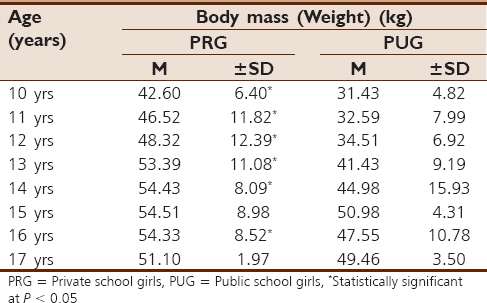 | Table 1: Summary of descriptive statistics of body mass in adolescent female school children in urban Lagos
Click here to view |
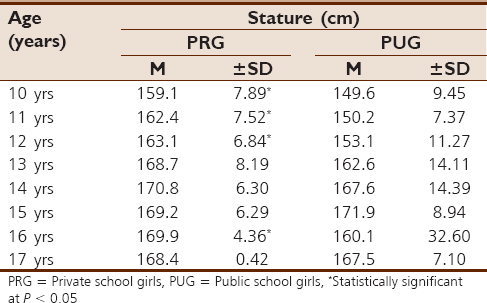 | Table 2: Summary of descriptive statistics of stature in adolescent female school children in urban Lagos
Click here to view |
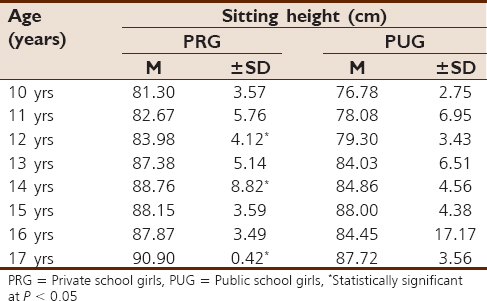 | Table 3: Summary of descriptive statistics of sitting height in adolescent female school children in urban Lagos
Click here to view |
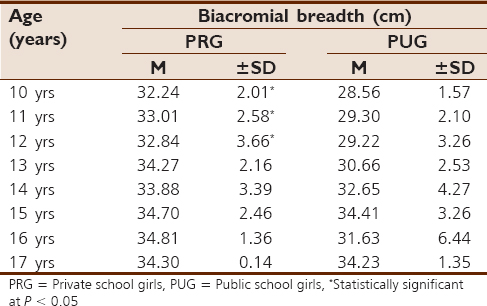 | Table 4: Summary of descriptive statistics of biacromial breadth in adolescent female school children in urban Lagos
Click here to view |
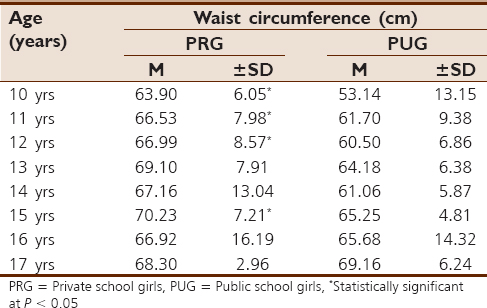 | Table 5: Summary of descriptive statistics of waist circumference in adolescent female school children in urban Lagos
Click here to view |
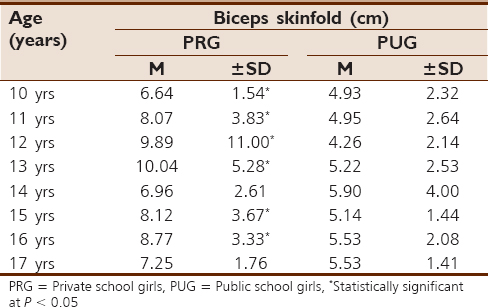 | Table 6: Summary of descriptive statistics of biceps skinfold in adolescent female school children in urban Lagos
Click here to view |
Body mass (weight) showed a marked rise as seen between 10 and 15 years among the private school girls [Table 1] as well as the public school girls. Statistically significant differences were observed at ages 10-14 and 16, with the private school girls show considerably higher values than public school girls.
The private school girls showed comparatively higher values of body stature than public school girls from 10 to 14 years, as well as at 16 to 17 years. However, at 15 years a reverse trend was observed. Statistically significant difference was observed at ages 10-12 and 16 years [Table 2].
Sitting height in the private school girls also showed considerable higher values than the public school girls across the age groups. There was also a progressive mean increase across the age groups, except a slight decline was observed at age 15 in the private school girls and 16 in the public school girls.
The same trend held for the waist circumference, biacromial breadth, and biceps skinfold with the girls from the private school having higher values than the girls from the public schools. The differences were comparatively more in the biceps skinfold.
| Discussion | |  |
Growth is a natural process that takes place in all living organisms and its pattern varies among individuals. Quantitative expression of the variation provides proper interpretation and evaluation of a child's development. Therefore, it is essential to have an accepted standard that reflects normal growth for the purpose of comparison.
The results obtained from this study showed that the adolescent private female schoolchildren recoded higher mean values than their public school counterparts in all parameters measured. According to a similar study, [25] this variation is as a result of variation in the growth of other body parts relative to variations in the onset of adolescent growth spurt. The observation of this age related pattern of variation is in concert with similar studies. [25],[26]
According to Ibeabuchi et al., [27] the result of the variation could be attributed to the less economically endowed neighborhoods of the urban Lagos. The existence of variations could also be explained by the influence of many exogenous factors such as environmental factors (e.g., availability of adequate health care, improved water supplies, transportation, roads, and electricity) and cultural differences where within the same opportunities, people's choices and preferences (e.g., infant feeding practices) may differ and is dependent where they reside and also dependent on value structure.
According to previous studies, the manifested variation reported in this study could be attributed to factors such as family characteristics, climate and low altitude which probably combine to mask the effect of the underlying growth pattern of these adolescent school children.
| Conclusion | |  |
This study has reported an anthropometric variation in growth pattern of adolescent female Nigerian school children in urban Lagos. This indicates variation in the growth pattern of these adolescents that may be a reflection of the variation in lifestyle patterns existing among the studied population.
| Acknowledgement | |  |
Special thanks to all principals and head teachers of the participating schools. We also acknowledge the assistance rendered by various form masters/mistresses, teaching staff, and class coordinators who assisted us in the collection of data. This appreciation would not be complete without thanking the pupils and students who graciously availed themselves and participated in the study. No organization or body funded this work.
| References | |  |
| 1. | Sharma JC. Chopra SR. Physical Growth and Development of the Maharastrians. Lucklow: Ethnographic and Folk Culture Society; 1970. p. 56.  |
| 2. | Malina RM, Bourchard C, Beunen G. Human growth: Selected aspects of currrent research on well-nourished children. Ann Rev Anthropol 1988:17:187-219.  |
| 3. | Wolanski N, Lasota A. Physical development of countryside children and youth aged 2 to 20 years as compared with the development of town youth of the same age. Z Morph Anthropol 1964;54:272-92.  |
| 4. | Eveleth PB, Tanner JM. Worldwide Variation in Human Growth. Cambridge, England: Cambridge University Press; 1990. p. 465.  |
| 5. | Meredith HV. Comparative findings on body size of children and youths living at urban centers and in rural areas. Growth 1979;43:95-104.  |
| 6. | Graham GG, MacLean WC Jr, Kallman CH, Rabold J, Mellits ED. Urban-rural differences in the growth of Peruvian children. Am J Clin Nutr 1980;38:338-44.  |
| 7. | Malina RM, Himes JH, Stepick CD, Lopeg FG, Busehang PH. Growth, maturation and physical performance. Am J Phys Anthropol 1998;54:327-36.  |
| 8. | Adak DK, Tiwari MK, Randhawa M, Bharati S, Bharati P. Pattern of adolescent growth among the brahmin girls - rural - urban variation. Coll Antropol 2002;26:501-7.  |
| 9. | Wang Y, Moreno LA, Caballero B, Cole TJ. Limitations of the current world health organization growth references for children and adolescents. Food Nutr Bull 2006;27(Suppl Growth Standard):S175-88.  |
| 10. | Chen E. Why socioeconomic status affects the health of children: A psychosocial perspective. Curr Dir Psychol Sci 2004;13:112-5.  |
| 11. | Chen E, Matthews KA, Boyce WT. Socioeconomic differences in children′s health: How and why do these relationships change with age? Psychol Bull 2002;128:295-329.  |
| 12. | Hasselberg M, Laflamme L. The social patterning of injury repetitions among young car drivers in Sweden. Accid Anal Prev 2005;37:163-8.  |
| 13. | Koster A, Bosma H, van Lenthe FJ, Kempen GI, Mackenbach JP, van Eijk JT. The role of psychosocial factors in explaining socio-economic differences in mobility decline in a chronically ill population: Results from the GLOBE study. Soc Sci Med 2005;61:123-32.  |
| 14. | Starfield B, Bergner M, Ensminger M, Riley AW, Green BF, Ryan S. Manual for the child health and illness profile: Adolescent edition (CHIP-AE). Baltimore, MD: Johns Hopkins University. 1995. p. 553-66.  |
| 15. | Starfield B, Riley AW, Witt WP, Robertson J. Social class gradients in health during adolescence. J Epidemiol Community Health 2002;56:354-61.  |
| 16. | Chen KW, Killeya-Jones LA. Understanding differences in marijuana use among urban black and suburban white high school students from two U.S. community samples. J Ethn Subst Abuse 2006;5:51-73.  |
| 17. | House JS, Landis KR, Umberson D. Social relationships and health. Science 1998;241:540-5.  |
| 18. | West P. Health inequalities in the early years: Is there equalization in youth? Soc Sci Med 1997;44:833-58.  |
| 19. | Wang Y, Tussing L, Odoms-Young A, Braunschweig C, Flay B, Hedeker D, et al. Obesity prevention in low socioeconomic status urban African-American adolescents: Study design and preliminary findings of the HEALTH-KIDS Study. Eur J Clin Nutr 2006;60:92-103.  |
| 20. | Cameron N, Gordon-Larsen P, Wrchota EM. Longitudinal analysis of adolescent growth in height, fatness, and fat patterning in rural South African black children. Am J Phys Anthropol 1994;93:307-21.  |
| 21. | Mangalore R, Knapp M, Jenkins R. Income-related inequality in mental health in Britain: The concentration index approach. Psychol Med 2007;37:1037-45.  |
| 22. | Wardle J, Robb K, Johnson F. Assessing socioeconomic status in adolescents: The validity of a home affluence scale. J Epidemiol Community Health 2002;56:595-9.  |
| 23. | Ogunlesi TA, Dedeke IO, Kuponiyi OT. Socioeconomic classification of children attending specialist paediatric centres in Ogun State, Nigeria. Niger Med Pract 2008;54:21-5.  |
| 24. | International Society for the Advancement of Kinanthropometry. International Standard for Anthropometric Assessment. Underdale, South Africa: ISAK; 2006.  |
| 25. | Uthman OA. Using extended concentration and achievement indices to study socioeconomic inequality in chronic childhood malnutrition: The case of Nigeria. Int J Equity Health 2009;8:22.  |
| 26. | Schneider D. International trends in adolescent nutrition. Soc Sci Med 2000;51:955-67  |
| 27. | Ibeabuchi NM, Mbagwu SI, Adelakun SA, Aniah JA, Olayemi TA, Adeyemi O. Anthropometric variations in the frame-size of adolescent male Nigerian school children in urban Lagos. J Anat Sci 2014;5;39-46.  |
[Table 1], [Table 2], [Table 3], [Table 4], [Table 5], [Table 6]
|